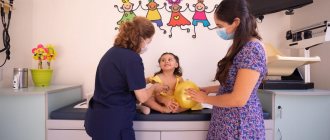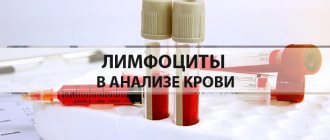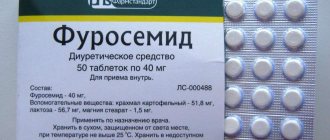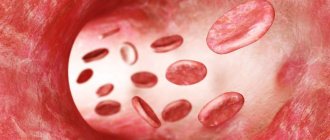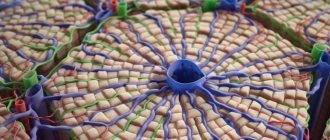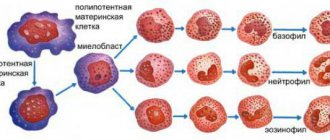Causes of neutrophilia
An increase in neutrophil levels does not always indicate any pathology. Since neutrophils are the first to react to any changes in the body, their numbers can increase in various situations.
The causes of physiological neutrophilia are as follows:
- Overeating (alimentary leukocytosis).
- Excessive physical activity.
- Emotional shock (emotional leukocytosis).
- Premenstrual syndrome in women.
- The period of bearing a child (second half of pregnancy).
- Childbirth.
- Sudden change in ambient temperature.
As a rule, a person does not know that his level of neutrophils in the blood increases. These conditions do not pose a threat to health and do not manifest any pathological symptoms. Therefore, most often a temporary increase in neutrophil levels goes unnoticed and goes away on its own.
However, if a person experiences certain symptoms of illness, and a blood test reveals an increase in the level of neutrophils, this may indicate the following pathologies:
- An inflammatory reaction is launched in the body. This can be any acute viral and bacterial infections, or purulent inflammation.
- A person develops a malignant neoplasm.
- A fungal infection develops in the body.
- The person received some kind of injury, ranging from burns to surgery.
- In pregnant women, neutrophilia may indicate eclampsia.
- In men and women, surges in neutrophil levels are sometimes a sign of diabetes.
- In the first 24 hours after surgery, the level of neutrophils will be increased, which is a normal reaction of the body to the intervention. If their indicators do not decrease on the second day after surgery, then this indicates the addition of an infection and requires additional treatment.
- With transfusion, neutrophil levels will be elevated. A similar situation is observed against the background of acute blood loss.
- Myocardial infarction always occurs against the background of neutrophilia.
- Bites from poisonous insects and snakes lead to an increase in the level of neutrophils in the blood.
How to increase neutrophils
It is impossible to buy a medicine that can increase neutrophil levels. However, it is still possible to influence their content in the blood. For example, if a decrease in phagocyte cells occurred while taking sulfonamide antibiotics, it makes sense to review the course of therapy with your doctor and replace the drugs.
In some cases, the production of neutrophils is affected by a pronounced imbalance of nutrients in the body. The most commonly reported levels of vitamin B9, known as folic acid, and B12 are significantly reduced. Therefore, often, if there is a lack of neutrophils, they additionally take an analysis for vitamin deficiency and prescribe a course of group B. 10-14 days after restoring the balance of nutrients in the body, an increase in the number of neutrophils is observed, which is fixed within acceptable values.
Types of neutrophilia depending on the degree of nuclear shift in the leukocyte formula
To make the correct diagnosis and prescribe treatment, it is important to take into account the degree of nuclear shift in the leukocyte formula:
- There is no nuclear shift. At the same time, the number of mature segmented nuclear neutrophils in the blood increases and general leukocytosis is diagnosed. A similar situation occurs after a hearty lunch, after physical exertion, during bleeding, or against the background of a mild infectious disease.
- Nuclear shift to the left. Neutrophilia is characterized by an increase in the number of polymorphonuclear neutrophils and a slight increase in myelocytes. A similar blood picture is characteristic of pneumonia, scarlet fever, diphtheria and typhoid.
- Neutrophilia is accompanied by a significant jump in the level of myelocytes. This will indicate a severe infection or purulent-septic inflammation.
- Neutrophilia with deregenerative nuclear shift. In this case, modified neutrophils appear in the blood, which signals severe infections and intoxications of the body, or indicates damage to the bone marrow.
- Neutrophilia with nuclear shifts to the left. Neutrophils with more than 5 segments are present in the blood. Sometimes they are found in healthy people, and sometimes they are a sign of Addison-Birmer anemia.
Correction
Conservative therapy
There are no direct ways to normalize the number of neutrophil granulocytes. To combat neutrophilia, it is necessary to treat the underlying disease against which it developed. Short-term neutrophilia after eating, stress or physical work does not require any intervention, as it is not a sign of disease or pathological condition. Neutrophilia resulting from surgery also does not need to be treated. In the case of persistent neutrophilia, you should consult a doctor to find out the cause and prescribe differentiated treatment:
- Antimicrobial (antiparasitic) therapy
. For bacterial infections, antibiotics (amoxicillin, cefixime) are used. For generalized infections (sepsis, bacterial endocarditis), it is necessary to use a combination of 2 antibacterial drugs. In case of helminthic infestation in a child, anthelmintic drugs (mebendazole) are prescribed. - Hemorheological therapy
. For heart attacks of any location caused by thrombosis or thromboembolism, antiplatelet drugs (acetylsalicylic acid), anticoagulant drugs (low molecular weight, unfractionated heparin), and sometimes thrombolytic drugs (alteplase) are used. - Antisecretory and antienzyme therapy
. In order to reduce the secretion of hydrochloric acid in peptic ulcers, proton pump inhibitors (omeprazole, pantoprazole), H2-blockers (famotidine, ranitidine) are used. To suppress the destructive action of proteolytic enzymes of the pancreas in acute pancreatitis and pancreatic necrosis, enzyme inhibitors (aprotinin) are effective. - Anti-inflammatory treatment
. To achieve remission of rheumatological diseases, medications are prescribed that stop the inflammatory process. These include glucocorticosteroids (prednisolone), 5-aminosalicylic acid derivatives (sulfasalazine), immunosuppressants (cyclophosphamide, methotrexate). - Chemotherapy.
For the treatment of malignant tumors, chemotherapeutic drugs (cytostatics, antimetabolites, hormone antagonists) are used in combination with radiotherapy. For oncohematological diseases, a combination of several antitumor agents is necessary.
Surgery
Many diseases accompanied by neutrophilia (mainly acute abdominal pathologies) require emergency surgical intervention - laparoscopic appendectomy, laparotomy and suturing of the ulcerative defect, cholecystectomy, opening and drainage of the abscess, etc. For myeloproliferative pathologies, in case of ineffectiveness of conservative therapy, they resort to stem cell transplantation cells.
Mechanisms of development of neutrophilia
There are several options for the development of neutrophilia, including:
- The process of maturation of neutrophils in the bone marrow starts at an accelerated pace. The increase in the number of neutrophils in the blood occurs within several days. A similar clinical picture is observed when a person has a malignant neoplasm in the body, or an infection develops that triggers purulent processes. The mechanism of accelerated maturation of neutrophils in the bone marrow is also called chronic neutrophilia. This process is activated against the background of stimulation of bone marrow fibroblasts with cytokines produced by macrophages and monocytes during inflammation or bacterial infection. Bone marrow fibroblasts, in turn, begin to produce hematopoietic growth factors, which are aimed at accelerating maturation and stimulating the release of neutrophils from the depot. The rate of neutrophil maturation can be increased 3 times (with purulent infection) or even more (with diseases of the blood system, with sepsis). The maximum number of neutrophils in the blood was reached after 7 days.
For a long time, the bone marrow is not able to provide the body with neutrophils, as its depot is depleted. At the same time, not only their number in the blood decreases, but also their life expectancy decreases. The prognosis in this case worsens significantly.
- Neutrophils are released from the bone marrow in an immature form, which occurs within a few hours. This neutrophilia is an acute condition and develops against the background of a pronounced inflammatory reaction. When there are not enough neutrophils circulating in the bloodstream to neutralize it, the bone marrow activates the reserve. To do this, it produces segmented and band forms of neutrophils. In the presence of acute inflammation in the body, such a reaction will not be triggered only if the production of neutrophils in the bone marrow is seriously impaired. For example, when a patient undergoes chemotherapy.
- Neutrophilia can develop due to the release of the marginal pool. It manifests itself within a few minutes. This neutrophilia is called pseudoneutrophilia. It is triggered by emotional shocks, intense physical activity, and treatment with catecholamines due to an increase in blood output from the heart. All of the above reasons lead to the fact that the speed of blood flow through the vessels increases, while leukocytes occupy an edge position, and the number of monocytes and lymphocytes increases.
- Neutrophilia with a decrease in the release of neutrophils from the bloodstream into the tissue. Neutrophils from the vascular bed can enter the tissue if they have certain structural defects. These can be congenital or acquired diseases. Modified neutrophils occupy a marginal position in the vessels and then leave their bed. Therefore, a similar situation can develop with almost any infection.
- Neutrophilia, which develops under the influence of several factors. In this case, several mechanisms will be launched simultaneously, leading to an increase in the number of leukocyte cells.
Diagnostics
Detection of neutrophilia requires differential diagnosis. To do this, you need to consult a general practitioner. In order to obtain primary information, anamnesis is collected - how long ago the symptoms appeared, whether there was recent contact with infectious patients, whether there was an increase in body temperature, pain, skin rashes.
If there is a suspicion of acute surgical abdominal pathology, the abdomen must be palpated for tension in the muscles of the anterior abdominal wall and the presence of a positive Shchetkin-Blumberg sign. However, it must be taken into account that these signs are difficult to identify in a child under 9 years of age. To confirm the diagnosis, additional examination is prescribed, including:
- Blood tests
. The total number and percentage of all types of leukocytes are calculated. The concentration of red blood cells, platelets, and inflammatory markers (ESR, CRP) is measured. The morphology of granulocytes (toxic granularity, karyopyknosis) is studied. In a septic condition, the level of presepsin and procalcitonin is determined. The presence of autoantibodies (anti-DNA, topoisomerase, antineutrophil antibodies) is checked. - Identification of the pathogen
. To identify the pathogenic microorganism, bacteriological culture, microscopy of sputum, urine, smear from the throat and tonsils are performed. To diagnose helminthiases, a stool test is performed for worm eggs, a blood test for specific immunoglobulins, and a scraping is taken from the child’s perianal folds. - Ultrasound
. A sign of pyelonephritis on an ultrasound of the abdominal cavity is expansion, thickening of the renal collecting system, pancreatitis - enlargement, diffuse changes in the pancreatic parenchyma, cholecystitis - thickening of the walls of the gallbladder, often the presence of stones. - X-ray
. On chest x-rays with pneumonia, foci of infiltration and darkening are visible. When the ulcer is perforated, the images reveal the presence of free gas in the abdominal cavity (“sickle symptom”). In case of inflammatory diseases of the joints, x-rays show a narrowing of the joint space and marginal osteoporosis. - ECG.
Electrocardiography during myocardial infarction reveals ST segment elevation, left bundle branch block, ventricular tachycardia, and other heart rhythm disturbances. With pulmonary embolism leading to pulmonary infarction, signs of overload of the right parts of the heart are detected - a deep Q wave in III, an S wave in lead I, a high pointed P wave (P-pulmonale) in leads II, III, aVF. - Histological studies
. A definitive diagnosis of cancer can only be made on the basis of a biopsy. The main feature of solid tumors is a large number of atypical cells. In case of leukemia, in the bone marrow biopsy, hyperplasia of the granulocytic lineage and the predominance of blast cells are noted; in the tissues of the lymph node in case of lymphomas, diffuse proliferation of cells with blast morphology is noted.
Symptoms and signs of neutrophilia
Neutrophilia is not a disease, so it is impossible to list its symptoms. They are determined by the disorder that provoked the surge in neutrophils.
Therefore, if the following symptoms occur, you should consult a doctor and take a blood test:
- Increased body temperature.
- Weakness and malaise.
- Pain of various localizations.
- Episodes of loss of consciousness.
- Increased sweating not associated with objective reasons.
- A sharp deterioration in health.
- Unexplained weight loss.
- Bleeding from the gastrointestinal tract.
Forecast
It is impossible to predict prognosis based on neutrophilia alone. It all depends on the disease that served as the background for the occurrence of neutrophilia. For example, a transient increase in the number of neutrophils after stress, food intake, or in a child on the first day of life is absolutely benign and transient. Conversely, severe purulent-septic pathologies and oncological diseases have a fairly high incidence of deaths. Therefore, any excess of the reference values of neutrophils (especially high and persistent ones) requires contacting a doctor.
What can affect test results?
Sometimes, if the level of neutrophils in the blood increases, the doctor recommends that the patient take another blood test. It is possible that the specialist has any doubts about the purity of the study. To eliminate the possibility of diagnostic inaccuracy, the following recommendations must be followed:
- The blood test must be taken strictly on an empty stomach. It is allowed to drink pure still water.
- Before taking a blood test, you need to exclude physical fatigue and emotional overload.
- It is important to avoid sudden changes in temperature, as this can cause an increase in neutrophil levels.
- During pregnancy, neutrophils may be elevated, which is normal.
Treatment of neutrophilia
Neutrophilia is not an independent disease. It only indicates that something is wrong in the body. To begin treatment, it is necessary to find out the exact cause of neutrophilia. Therefore, the patient must undergo a comprehensive diagnosis.
When infectious processes in the body are confirmed, antiviral, antibacterial or antimycotic treatment is required (depending on the type of pathogen). To increase the body's resistance, immunostimulants can be prescribed. Corticosteroids are indicated when the patient has rheumatic lesions. Emotional neutrophilia requires the use of sedatives. In severe cases, leukapheresis is performed. This procedure allows you to cleanse the blood of excess leukocytes.
The neutrophil level is the most important indicator of the health or unhealth of a patient. It must be taken into account when conducting a blood test.
Author of the article:
Mochalov Pavel Alexandrovich |
Doctor of Medical Sciences therapist Education: Moscow Medical Institute named after. I. M. Sechenov, specialty - “General Medicine” in 1991, in 1993 “Occupational diseases”, in 1996 “Therapy”. Our authors



